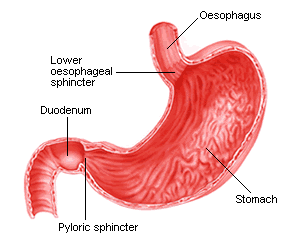This salt alternative could help reduce blood pressure. So why are so few people usingit?

The stomach and duodenum are part of the upper gastrointestinal tract. The stomach is a muscular pouch located in the upper left abdomen, and the duodenum leads off the stomach, forming the beginning of the small intestine.
Stomach
The stomach is a J-shaped muscular pouch in the continuous tube that is the digestive tract.
This muscular organ that is the stomach, sits in the upper left part of the abdominal cavity. It stores food and breaks it down, and can expand to hold more than a litre of food after a meal.
The lower oesophageal sphincter is a ring of smooth muscle that controls the entry of food from the oesophagus into the stomach. Once food has passed into the stomach, the sphincter closes to prevent the acidic stomach contents from coming back up. In people who have gastro-oesophageal reflux the sphincter may be faulty.
Once food enters the stomach, the muscles within the stomach walls contract and squeeze strongly to mix the food and break it into smaller pieces, and the lining of the stomach secretes acid and enzymes important for the digestion of protein. The enzyme pepsin is responsible for breaking down protein in the stomach.
The lining of the stomach walls has ridges called rugae, which allow the stomach to expand and also help channel liquid internally.
A layer of mucus protects the stomach from the hydrochloric acid in the digestive juices. The stomach acid ensures that most bacteria are killed in the stomach.
Once food is semi-digested it is known as chyme and is passed through the pyloric sphincter, a ring of smooth muscle at the lower part of the stomach, by muscular contractions into the duodenum.
The pyloric sphincter controls this exit of partially-digested food from the stomach into the duodenum, so that only small amounts are passed through at a time.
Duodenum
The duodenum is the first part of the small intestine. (The other parts are the jejunum and the ileum.) Digestion continues in the duodenum once the chyme enters from the stomach. The stomach acid is neutralised in the duodenum because of its alkaline environment. The entry of chyme triggers the release of digestive pancreatic enzymes and bile which enter the duodenum via the pancreatic and common bile ducts, respectively. These 2 ducts join the duodenum at the ampulla of Vater, or the hepatopancreatic ampulla.
The pancreatic juice contains enzymes and bicarbonate to neutralise the stomach acid. The pancreatic enzymes are lipase (breaks down fats), protease (breaks down protein) and amylase (breaks down carbohydrates).
Bile is a dark green or brownish coloured fluid produced by the liver. Bile is passed to the gallbladder and then into the duodenum to help with the digestion of fat.
The chyme is gradually pushed down the duodenum by peristaltic waves which flow down the length of the digestive tract.
Most of the digestion of the protein, fats and carbohydrate in the chyme is done by the enzymes in the duodenum, before the resultant mixture is passed further into the small intestine.
Related
ncG1vNJzZmilqZm%2Fb6%2FOpmWarV%2BcrrTA0aigp6yVqMGqusClZKGdkaHBqXvSraammZOdeqK6w2abrqeUmru2uY4%3D